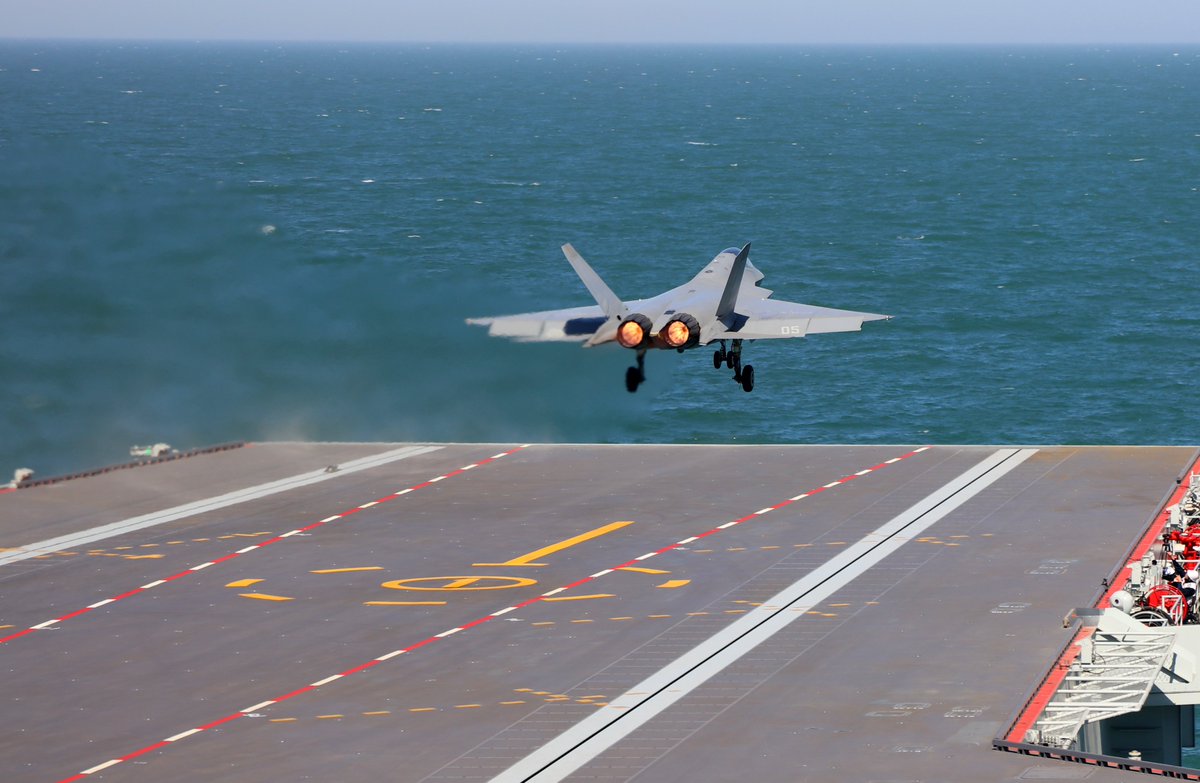
The official channels of the Chinese Navy (PLAN) have published a series of videos confirming the start of flight operations on the conventional aircraft carrier FUJIAN during its 9th sea trial, part of the testing campaign that began in May 2024 in preparation for its entry into service.
Videos and images, some of which relate to previous sorties, show for the first time the unit's CATOBAR operations, with launches via catapults and recovery via 4 arresting wires, of 3 types of aircraft: the KJ-600 AEW&C, and J-15T and J-35 fighters.
The material clearly aims to highlight the new role of the Chinese Navy and its transformation into a real blue-water naval force.
Flight operations aboard the FUJIAN are not a surprise themselves, considering other images and videos published by the PLAN in early 2025. Nevertheless, several aspects deserve further investigation. All observable launches appear to take place from the left bow catapult. It is unclear whether this is merely a coincidence in the editing of the footage or whether it highlights a technical reason, such as the different operational states of the 3 electromagnetic catapults and other related equipment.
Another element that should be highlighted is that the deflector to protect against engine exhausts related to the central catapult seems to interfere with the landing area, which could limit the ship's ability to perform simultaneous landings and launches.
The FUJIAN carries no less than 3 KJ-600 AEW&C aircraft, a factor that would underscore the progress made in the use of shipborne early warning platforms, one of the key capabilities that distinguishes the FUJIAN from the other 2 Chinese aircraft carriers, the LIAONING and SHANDONG. Both of the first two aicraft carriers lack catapults and are therefore unable to operate fixed-wing AEW&C aircraft, which are essential for extending the fleet's detection, defense, and battle management capabilities.
The video also provides an overview of overall operations aboard the FUJIAN. The PLAN's decision to follow the US Navy's established operational concepts is evident, in particular the ‘color coding’ of personnel operating on the flight deck: yellow for catapult operators and flight directors, blue for personnel dedicated to general aircraft handling (and also refueling in the Chinese case, while the US have purple vests), and white for security and control personnel. The structure of the shipborne component has also been ‘copied’, consisting of a latest-generation J-35 stealth fighter (the ‘equivalent’ of the F-35C), a J-15T multi-role aircraft (F/A-18E/F), a platform dedicated to EW tasks such as the J-15DT (not visible in the above material, and comparable to the EA-18G) and, finally, an AEW&C KJ-600 aircraft (equivalent to an E-2C/D HAWKEYE), pending the development of a variant of the KJ-600 for transport and liaison operations (read C-2 GREYHOUND).
That said, the most surprising element is certainly the use of (at least) one electromagnetic catapult for launching its aircraft, which certifies the entry of the PLAN, the first non-Western navy, into the club of conventional aircraft carriers alongside the United States and France. In fact, specifically, the FUJIAN allows China to enter an even more exclusive club, consisting only of the US so far, when it comes to electromagnetic rather than steam-powered catapults.
EMALS, in addition to being less cumbersome, ensure greater precision in controlling the final launch speed, with acceleration profiles that can be customized according to the aircraft and its load, a feature that significantly reduces stress on the airframes and arresting devices. Of course, their electrical management represents a considerable challenge in the case of high-frequency launch and recovery cycles and a high number of sorties, especially in tropical heat.
However, from an operational point of view, this means no more limits or compromises on payload imposed by ski jumps for China. Beijing now has the ability to launch its fighters at full load (with more fuel and weapons), providing the PLAN with unprecedented range and flexibility, albeit limited by the unit's steam turbine and diesel generator propulsion.
Another aspect to highlight is the use of J-35 stealth fighters in the naval variant, which distinguishes the Chinese unit from its US counterpart, represented by the FORD aircraft carrier. Despite official certification, the latter has not yet launched any F-35Cs from its electromagnetic catapults. The reason for this is that Congress had imposed budget restrictions due to repeated delays and cost overruns during the construction and deployment of the FORD. This led to the decision to postpone the deployment of the F-35C on the FORD until 2027, which means that for the next 18 months, the USN and USMC F-35C squadrons will operate solely from NIMITZ-class aircraft carriers.
Even once it enters service with the Chinese Navy, probably at the end of the year or early 2026, the FUJIAN will have to devote at least another 2 years to further sea trials, unit qualification activities, aircraft, personnel, and flight operations to achieve initial operational capability.
At the same time, it cannot be ignored that, in just 20 years, the PLAN has gone from restructuring a former Soviet STOBAR-type aircraft carrier to operating 3 aircraft carriers, 2 of which were built in China, with one of these – the FUJIAN – among the largest and, at least in some respects, most modern in the world. This is the result of methodical and persistent development and modernization, which the Chinese Navy continues to pursue at an unrelenting pace.








